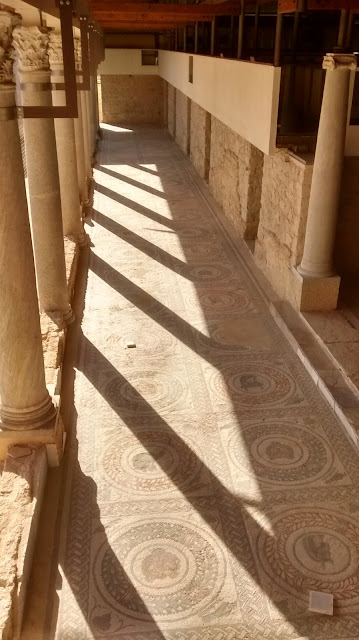Monday 10th February, 2016
 |
| NOT 'The Bikini Girls' |
The Roman mosaics at Villa Casale are forever associated in the popular imagination as the site of the 'bikini girls, a group of scantily clad female figures wearing what appear to be two piece swimsuits. The term, however, is both a misnomer and somewhat of an injustice. If we were to characterise the women's clothing in modern terms what we are looking at here is Lycra sportswear, not new season beachwear from Marcus Spenceria.
Bikini girls' is an injustice because the scene depicted is not a 'glamour shoot' but an athletics competition. These are the ancient equivalents of Paula Radcliffe or Jessica Ennis, not Kate Moss or Abi Clancy.
In terms of one of the key themes of the mosaics this is not a frivolous point. The imagery in a number of the rooms makes reference to Dionysian mysteries, here, however the representation of the cult is not orgiastic, rather a celebration of earthly pleasures - bucolic and pastoral.
 |
| Pan leads his devotees. |
 |
| The hunt - carrying back the prey. |
 |
| and awterwards - a BBQ! |
The scale of the Villa Casale is palatial, leading to speculation that it was built as an imperial retreat for Diocletian's lesser known co-emperor, Maximian Herculeus, but actually the identity of the owner is uncertain.
The huge mosaic covering the central ambulatory depicts the trade in exotic animals from Africa and Asia. This has led to a second theory that the villa was built by a rich merchant who specialised in this lucrative, but presumably dangerous trade. Rowing a merchant ship from Carthage to Ostia packed full of elephants, lions and ostriches seems like a highly hazardous business to me.
 |
| a hazardous trade - exporting elephants. |
The mosaics date from the beginning of the 4th century, and in style are a mixture of classical poses and gesture, but display a lively realism and the flattening of form associated with late antiquity. They are full of humour and a vivacious celebration of good living. It is difficult not to reflect on the fact that they all date to within a decade or two of Constantine's adoption of Christianity as the dominant faith of the Roman Empire. There is no sense in these scenes of 'guilty pleasures'. Graeco-Roman culture did not have the same sense of a fall from Eden that pervades Christian thought. Maybe these mosaics are the very last depiction of the culture of pre-Christian Europe.
 |
| Some of the most delightful mosaics depict children playing fanciful games |
I think these mosaics are an absolute must see for anyone visting Sicily. They are situated in a lovely little valley a few kilometres west of the mountain town of Piazza Armerina. If you are travelling by motorhome there is not a convenient campsite, but a few overnight parking places are listed nearby including a sosta in Piazza Armerina itself. Our various books and apps were a bit contradictory as to whether staying overnight in the Villa Casale car-park would be an option. In fact the young man in the car-park ticket booth eventually agreed that we could, perhaps a little reluctantly. It transpired that outside of the Villa's opening hours the barriers are left open. We paid 3 euros for when we arrived mid- afternoon until closing time. Thereafter it was free, so long as we vacated the car park by 8am the following morning.
The car park is huge with the bays specially sized for motorhomes at the far end. Once the last tour bus full of noisy French teenagers departed at about 5pm we were left in splendid isolation. As night fell it became clear just how isolated we were, the only street lights were at the entrance a couple of hundred metres away. We were lost in the gloom, which was splendid for star-gazing, but very unsplendid at about 10pm when the van's leisure batteries failed and we were plunged into pitch blackness. After a couple of chaotic minutes blindly feeling our way about the van looking for torches I managed to start the engine and left it chugging away for fifteen minutes in an attempt to recharge the batteries enough to give us power overnight to run the pumps for the Thetford and main water tank. Ten minutes in the pitch dark was quite enough for us to realise how ignorant we were about the van's systems, and also time to grow a little apprehensive at how remote a spot we were parked in. We are definitely nervous free-campers. I fell asleep listening carefully for marauding thieves and vagabonds, though quite what I would have done if marauders had materialised I have no idea. The other thought that drifted through my mind was that is was all very well being able to differentiate between an urn and an amphora, but right now telling an ohm from an amphere would be more use. Really an ideal travelling companion for long term motorhoming is a mechanical engineer; Gill, unfortunately is saddled with an art historian, who is about as much use as a chocolate teapot when the lights fail.
 |
| Parked-up in lone splendour |
e














No comments:
Post a Comment